AUDI S4 CABRIOLET 2009 Owners Manual
Manufacturer: AUDI, Model Year: 2009, Model line: S4 CABRIOLET, Model: AUDI S4 CABRIOLET 2009Pages: 340, PDF Size: 77.32 MB
Page 171 of 340
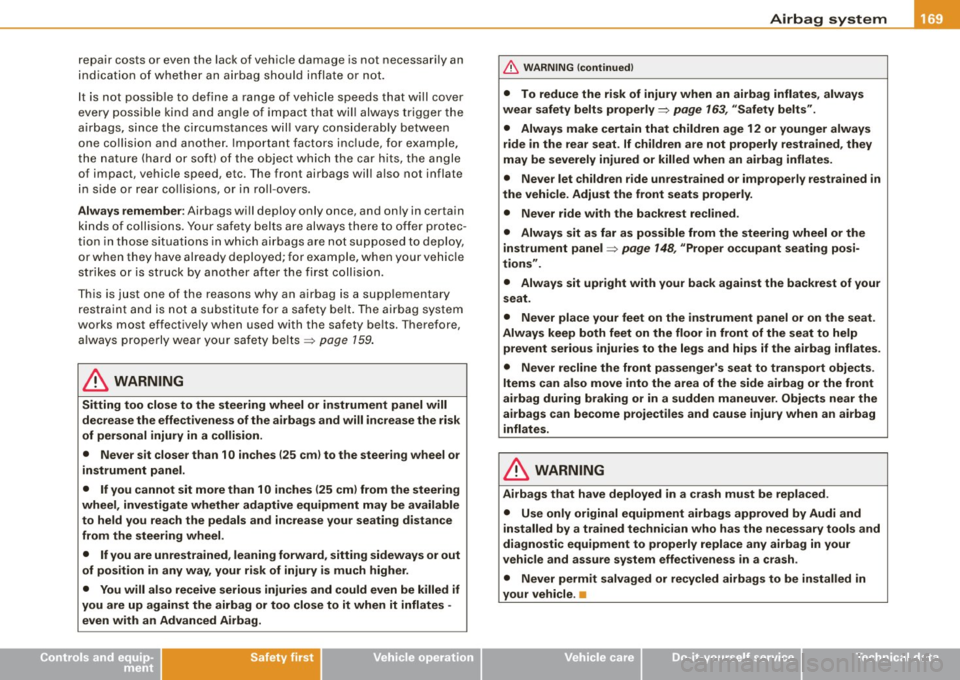
__________________________________________________ A_ i_ r _b _a...; g::- s_ y=--- s_t _e _m ___ lJII
repair costs or even the lack of vehicle damage is not necessarily an
indication of whether an airbag should inflate or not .
It is not possible to define a range of vehicle speeds that will cover
every possible kind and angle of impact that will always trigger the
airbags, since the circumstances will vary considerably between
one collision and another. Important factors include, for example,
the nature (hard or soft) of the object which the car hits, the angle of impac t, vehicle sp eed , etc . The front airbags will also not inflate
in side or rear collisions, or in roll-overs.
Always remember : Airbags will deploy only once, and only in certain
kinds of collisions. Your safety belts are always there to offer protec
tion in those situations in which airbags are not supposed to deploy,
or when they have already deployed; for example, when your vehicle
strikes or is struck by another after the first collision.
This is just one of the reasons why an airbag is a suppl em entary
restraint and is not a substitute for a safety belt. The airbag system
works most effectively when used with the safety belts. Therefore ,
always properly wear your safety belts=>
page 159.
& WARNING
Sitting too close to the steering wheel or instrument panel will
decrease the effectiveness of the airbags and will increase the risk
of personal injury in a collision.
• Never sit closer than 10 inches (25 cm) to the steering wheel or
instrument panel.
• If you cannot sit more than 10 inches (25 cm) from the steering
wheel, investigate whether adaptive equipment may be available
to held you reach the pedals and increase your seating distance
from the steering wheel.
• If you are unrestrained, leaning forward, sitting sideways or out
of position in any way, your risk of injury is much higher.
• You will also receive serious injuries and could even be killed if
you are up against the airbag or too close to it when it inflates -
even with an Advanced Airbag.
Controls and equip ment Safety first
Vehicle operation
& WARNING (continued)
• To reduce the risk of injury when an airbag inflates, always
wear safety belts properly~
page 163, "Safety belts".
• Always make certain that children age 12 or younger always
ride in the rear seat. If children are not properly restrained, they
may be severely injured or killed when an airbag inflates.
• Never let children ride unrestrained or improperly restrained in
the vehicle. Adjust the front seats properly.
• Never ride with the backrest reclined.
• Always sit as far as possible from the steering wheel or the
instrument panel~
page 148, "Proper occupant seating posi
tions".
• Always sit upright with your back against the backrest of your
seat.
• Never place your feet on the instrument panel or on the seat .
Always keep both feet on the floor in front of the seat to help
prevent serious injuries to the legs and hips if the airbag inflates.
• Never recline the front passenger's seat to transport objects.
Items can also move into the area of the side airbag or the front
airbag during braking or in a sudden maneuver. Objects near the
airbags can become projectiles and cause injury when an airbag
inflates.
& WARNING
Airbags that have deployed in a crash must be replaced.
• Use only original equipment airbags approved by Audi and
installed by a trained technician who has the necessary tools and
diagnostic equipment to properly replace any airbag in your
vehicle and assure system effectiveness in a crash.
• Never permit salvaged or recycled airbags to be installed in
your vehicle. •
Vehicle care Do-it-yourself service Technical data
Page 172 of 340
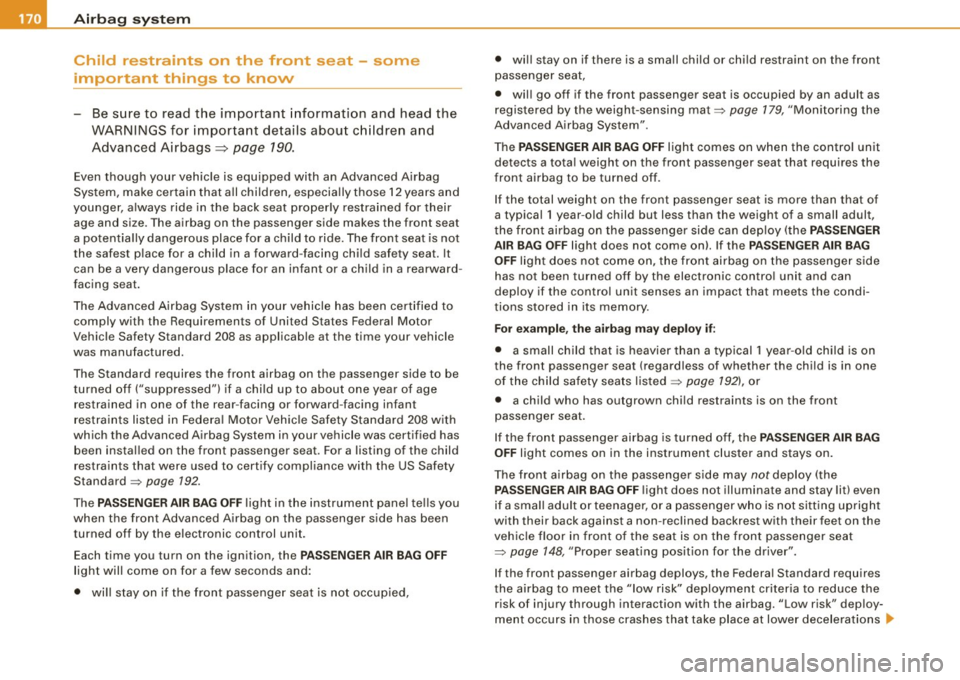
___ A_ ir_b _ a_ g~ s_ y_s _t _e _m _________________________________________________ _
Child restraints on the front seat - some
important things to know
- Be sure to read the important information and head the
WARNINGS for important details about children and
Advanced Airbags~
page 190.
Even though your vehic le is equipped with an Advanced Airbag
System, make certain that a ll children, especia lly those 12 years and
younger, a lways ride in the back seat properly restrained for their
age and size . The airbag on the passenger side makes the front seat
a potentia lly dangerous place for a child to ride. The front seat is not
the safest p lace for a chi ld in a forward -facing child safety seat. It
can be a very dangerous place for an infant or a child in a rearward
facing seat.
The Advanced Airbag System in your vehicle has been certified to
comply with the Requirements of United States Federal Motor
Vehicle Safety Standard 208 as applicab le at the time your vehicle
was manufactured.
Th e Standard requires the front airbag on the passenger side to be
turned off ("suppressed") if a chi ld up to about one year of age
restrained in one of the rear-facing or forward-facing infant
restraints listed in Federa l Motor Vehicle Safety Standard 208 with
which the Advanced Airbag System in your vehicle was certified has been instal led on the front passenger seat. For a listing of the child
restraints that were used to certify compliance with the US Safety
Standard =>
page 192.
The PASSENGER AIR BAG OFF light in the instrument panel tells you
when the front Advanced Airbag on the passenger side has been
t urned off by the electronic control unit.
Each time you turn on the ignition, the
PASSENGER AIR BAG OFF
light will come on for a few seconds and:
• will stay on if the front passenger seat is not occupied, •
will stay on if there is a small child or child restraint on the front
passenger seat,
• will go off if the front passenger seat is occupied by an adult as
registered by the weight-sensing mat=>
page 179, "Monitoring the
Advanced Airbag System" .
The
PASSENGER AIR BAG OFF light comes on when the control unit
detects a tota l weight on the front passenger seat that requires the
front airbag to be turned off.
If the total weight on the front passenger seat is more than that of
a typical 1 year -old child but less than the weight of a small adult,
the fron t airbag on the passenger side can deploy (the
PASSENGER
AIR BAG OFF
light does not come on). If the PASSENGER AIR BAG
OFF
light does not come on, the front airbag on the passenger s ide
has not been turned off by the electronic contro l unit and can
deploy if the control unit senses an impact that meets the condi
tions stored in its memory.
For example, the airbag may deploy if:
• a small ch ild that is heavier than a typical 1 year-o ld child is on
the front passenger seat (regardless of whether the child is in one
of the child safety seats listed =>
page 192), or
• a child who has outgrown chi ld restraints is on the front
passenger seat .
If the front passenger airbag is turned off, the
PASSENGER AIR BAG
OFF
light comes on in the instrument cluster and stays on.
The front airbag on the passenger side may
not deploy (the
PASSENGER AIR BAG OFF light does not illuminate and stay lit) even
if a small adult or teenager, or a passenger who is not sitting upright
with their back against a non -reclined backrest with their feet on the
vehicle floor in front of the seat is on the front passenger seat
=>
page 148, "Proper seating position for the driver".
If the front passenger airbag deploys, the Federal Standard requires
the airbag to meet the "low risk" deployment criteria to reduce the
risk of injury through interaction with the airbag. "Low risk" deploy
ment occurs in those crashes that take p lace at lower decelerations .,.
Page 173 of 340
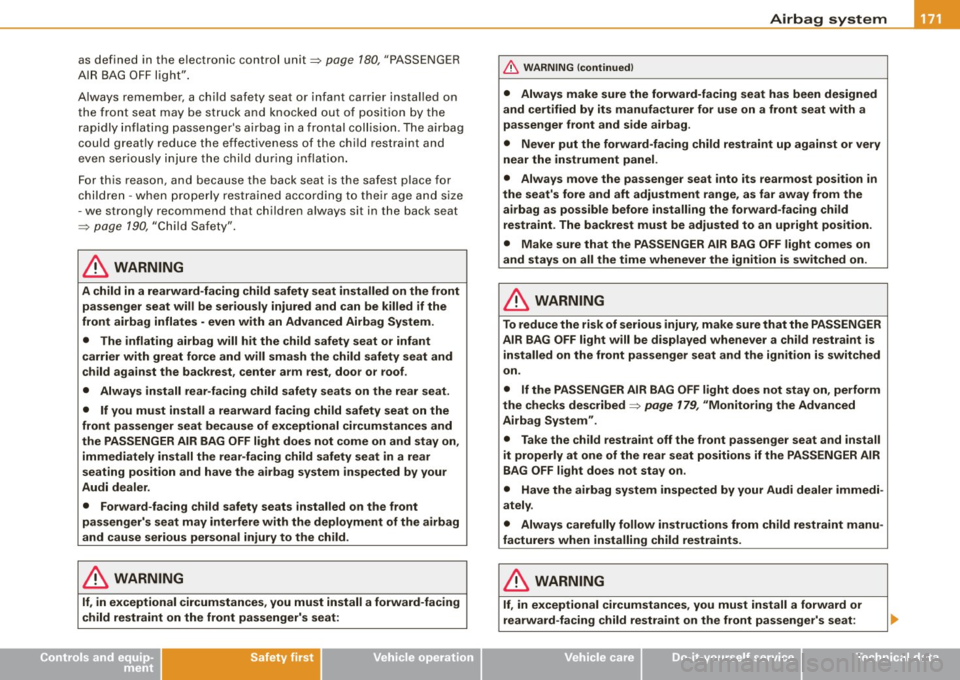
Airbag system -----------------=~-
as defined in the electronic contro l unit:::::, page 18 0, "P ASSENG ER
A IR BAG OFF lig ht".
A lways remember, a ch ild safety s eat or infant carrier insta lled on
the front seat may be struck a nd knocked out of position by the
rap id ly infl atin g p ass eng er's ai rba g in a front al co llision . The air bag
co uld greatly reduce the effectiveness of the chi ld re st raint and
e v en s erio usl y inju re the chi ld during inflati on.
F or this reason, and because the bac k seat is t he safest plac e for
c hi ldr en -w he n prop erly res train ed acc ordi ng to th eir age a nd size
- w e stro ng ly recomme nd that c hildren a lways s it in t he bac k seat
::::;, page 190, "Chil d Safe ty" .
& WARNING
A child in a rearward -facing child safety seat installed on the front
passenger seat will be seriously injured and can be killed if the
front airbag inflates - even with an Advanced Airbag System.
• The inflating ai rbag will hit the child safety seat or infant
carrier with great force and will smash the child safety seat and
child against the ba ckrest , center arm rest , door or roof.
• Always install rear-facing child safety seats on the rear seat. • If you must install a rearward facing child safety seat on the
front passenger seat because of exceptional circumstances and
the PASSENGER AIR BAG OFF light does not come on and stay on,
immediately install the rear-facing child safety seat in a rear
seating position and have the airbag system inspected by your
Audi dealer .
• Forward-facing child safety seats installed on the front
passenger's seat may interfere with the deployment of the airbag
and cause serious personal injury to the child .
& WARNING
If, in exceptional circumstances , you must install a forward-facing
child restraint on the front passenger's seat:
Controls and equip ment Safety first
Vehicle operation
& WARNING (continued)
• Always make sure the forward-facing seat has been designed
and certified by its manufacturer for use on a front seat with a
passenger front and side airbag .
• Never put the forward -facing child restraint up against or very
near the instrument panel .
• Always move the passenger seat into its rearmost position in
the seat's fore and aft adjustment range, as far away from the
airbag as possible before installing the forward-facing child
restraint. The backrest must be adjusted to an upright position.
• Make sure that the PASSENGER AIR BAG OFF light comes on
and stays on all the time whenever the ignition is switched on.
& WARNING
To reduce the risk of serious injury, make sure that the PASSENGER
AIR BAG OFF light will be displayed whenever a child restraint is installed on the front passenger seat and the ignition is switched
on.
• If the PASSENGER AIR BAG OFF light does not stay on , perform
the checks described :::::,
page 179, "Monitoring the Advanced
Airbag System" .
• Take the child restraint off the front passenger seat and install
it properly at one of the rear seat positions if the PASSENGER AIR
BAG OFF light does not stay on .
• Have the airbag system inspected by your Audi dealer immedi
ately .
• Always carefully follow instructions from child restraint manu
facturers when installing child restraints .
& WARNING
If, in exceptional circumstances, you must install a forward or
rearward-facing child restraint on the front passenger's seat :
Vehicle care Do-it-yourself service Technical data
Page 174 of 340
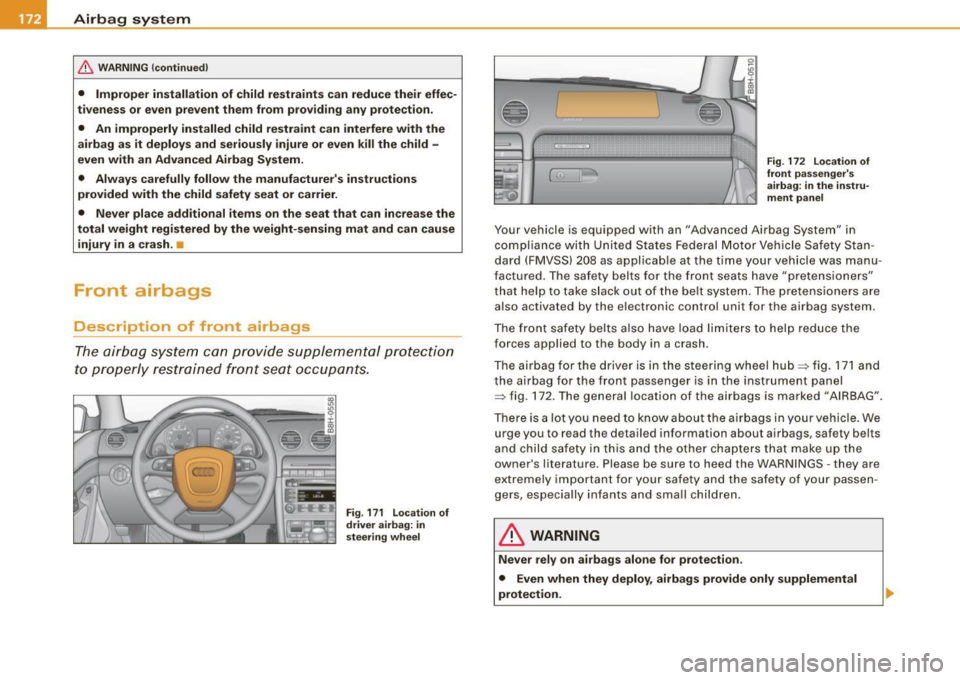
-Airbag system --=----=----------------
& W
ARNING (continued )
• Improper installation of child restraints can reduce their effec
tiveness or even prevent them from p roviding any protection .
• An improperly installed child restraint can interfere with the
airbag as it deploys and seriously injure or even kill the child -
even with an Advanced Airbag System .
• Always carefully follow the manufa cturer's instru ctions
provided with the child safety seat or carrier .
• Never place additional items on the seat that can increase the
total weight registered by the weight-sensing mat and can cause injury in a crash .
LJ
Front airbags
Description of front airbags
The air bag sy stem can provi de su ppleme ntal pr ote ct io n
to prope rly r estrai ned fron t se at occu pants.
Fig. 1 7 1 L ocation of
driver airbag: in
s teeri ng w heel
Fig . 172 Location of
fron t pa ssenger' s
airbag : in the in stru
ment panel
Your vehicle is equipp ed with an " Advanced Airbag System" in
complia nce wit h United States Federal Motor Vehicle Safe ty Stan
dard (FMVSS) 208 as appl icab le at the time your veh icle was manu
f act ured. The safety bel ts for the front seat s have "pretensi one rs"
t ha t help to take slack ou t of the be lt s ystem. The p re tens io ne rs a re
also activated by the electronic control unit for the airbag system.
The fr ont safe ty belts als o h ave loa d lim iters to hel p reduce the
forces applied to the body in a crash.
The a irbag f or the driver is i n the st eeri ng wheel hub~ fig. 171 a nd
t h e airbag for the front passenger is in the i nstrument panel
~ fig. 172. The genera l location of the airbags is marked "AIRBAG".
There is a lot you need to know ab out t he airbags in y our vehicle. We
u rge you to read the deta iled information about airbags, safety belts
and child s afety i n th is and th e other c ha pt ers t hat make u p the
owner's literature. Please be sure to heed the WARN INGS -they are
e xt reme ly im portan t for y our safe ty a nd the safe ty of y our passen
gers, especia lly infants and small childr en.
& WARNING
Never rely on airbags alone for protection .
• Even when they deploy, airbags provide only supplemental
protect ion .
Page 175 of 340
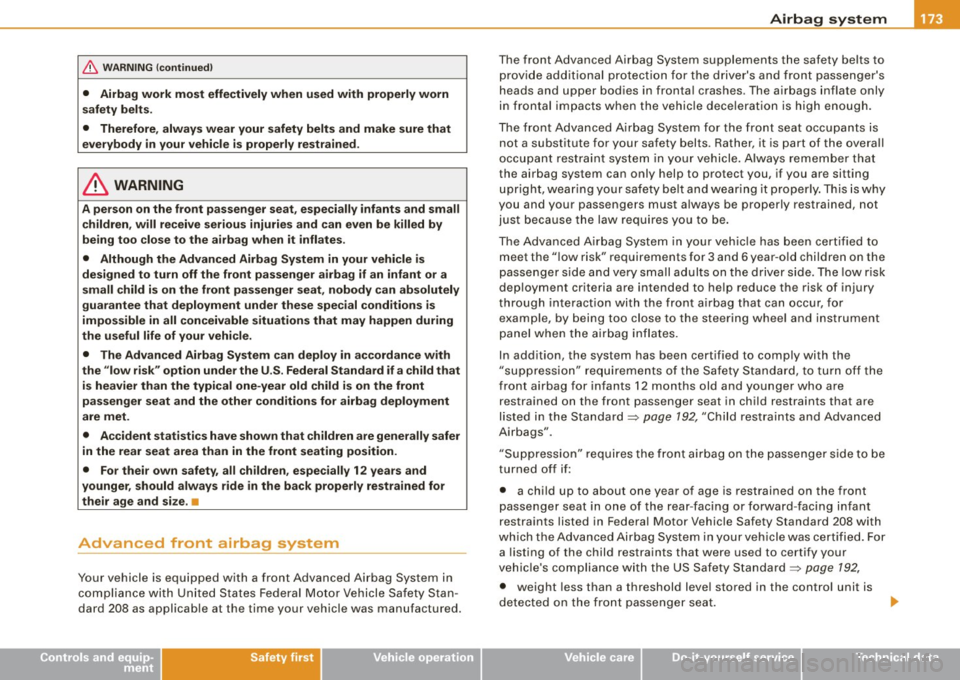
Airbag syst em -----------------=~-
& WARNIN G (cont in u ed)
• Airb ag work m ost effectiv ely when u sed with properly worn
sa fet y be lt s .
• Ther efore , always wear your safety belt s and ma ke sure that
eve rybod y in your vehi cle is prope rly re str ained.
& WARNING
A person on the front p assenger se at, espe cially infant s and small
c hildren , will re ceive seriou s injuries and can ev en be killed by
being t oo clos e to the airbag when it infl ates.
• Although the Adva nced Airbag System in your ve hicle i s
de signed to turn off the front passenger airb ag i f a n infant or a
s mall child i s on the front pa ssenger seat , nobody can absolutely
gu ara ntee that deployment under these spe cial co nditio ns is
impos sible in all conceivable situations that m ay happen during
the useful life of your vehicle.
• The Adv an ced Airbag Sy stem can deploy in a ccordance with
the "lo w risk" option unde r the U .S. Feder al Stand ard if a child t hat
is heavier than the typi cal on e-year old child i s on th e front
pa sse nger seat an d the other condition s for airb ag dep loym ent
are met.
• Acc ident stat istics have sh own that children are gen erally s afer
in the rear se at area than in the front seating posit ion .
• For th eir own safet y, all children , espe cially 12 yea rs and
younger , should alway s ride in th e back properly r estrained for
their age and size. •
Advanced front airbag system
Your vehicle is equipped with a front Advanced Airbag System in
compliance with United States Federal Motor Vehicle Sa fety Stan
dard 208 as applicable at the time your vehicle was manufactured.
Controls and equip
ment Safety first Vehicle operation
The front Advanced Airbag System supplements the safety belts to
provide additional protection for the driver's and front passenger's
heads and upper bodies in frontal crashes. The airbags inflate only
in frontal impacts when the vehic le deceleration is high enough.
The front Advanced Airbag System for the front seat occupants is not a substitute for your safety belts . Rather, it is part of the overall
occupant restraint system in your vehicle. A lways remember that
the airbag system can only help to protect you, if you are sitting
upright, wear ing your safety be lt and wear ing it proper ly . This is why
you and your passengers must a lways be properly restrained, not
just because the law requires you to be .
The Advanced A irbag System in your veh ic le has been certified to
meet the "low risk" requirements for 3 and 6 year -o ld children on the
passenger side and very small adults on the driver side. The low risk
deployment criteria are intended to he lp reduce the risk of injury
through interact ion with the front airbag that can occur, for
examp le, by being too close to the steering whee l and instrument
panel when the airbag inflates.
In addition, the system has been certified to comply with the
"suppression" requirements of the Safety Standard, to turn off the
front airbag for infants 12 months old and younger who are restrained on the front passenger seat in child restraints that are
listed in the Standard~
page 192, "Child restraints and Advanced
Airbags".
"S uppression" requi res the front ai rbag on the passenger side to be
turned off if:
• a child up to about one year of age is restrained on the front
passenger seat in one of the rear-facing or forward-facing infant
restraints listed in Federal Motor Vehicle Safety Standard 208 with
wh ich the Advanced Airbag System in your vehicle was certified. For
a listing of the child restraints that were used to certify your
vehic le's compliance wi th the US Safety Standard ~
page 192,
• weight less than a threshold leve l stored in the control unit is
detected on the front passenger sea t. _.
Vehicle care Do-it-yourself service Technical data
Page 176 of 340
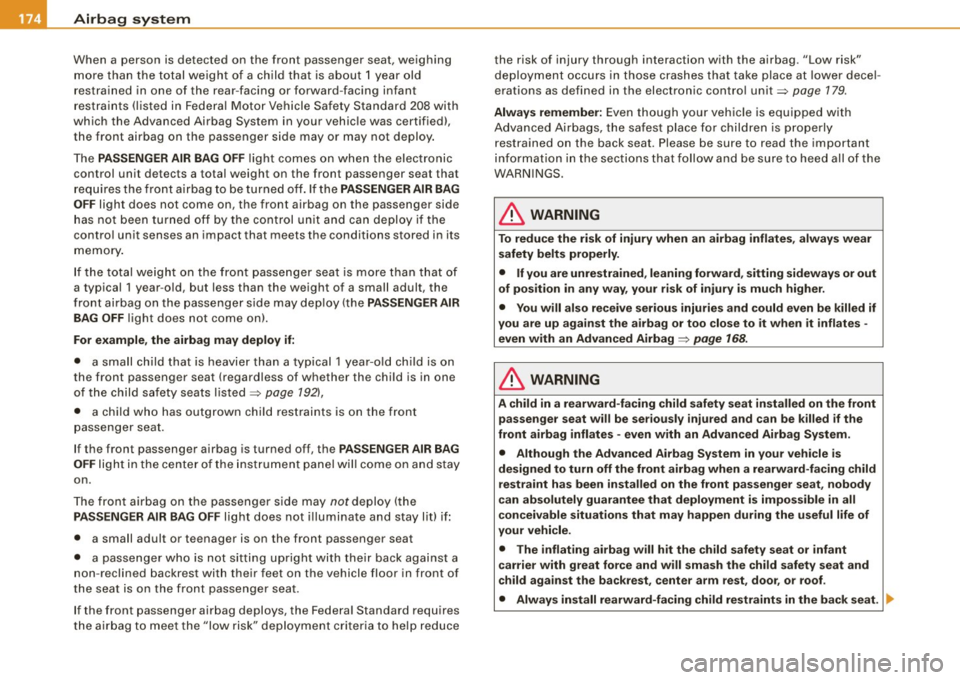
___ A_ ir_b _ a_ g~ s_ y_s _t _e _m _________________________________________________ _
When a person is detected on the front passenger s eat, wei ghing
mo re tha n th e to ta l w eigh t of a c hild th at is a bout 1 year old
r estra in ed in one of th e rear -faci ng or forward -fac ing infa nt
r e str aints (lis ted i n Fede ra l M otor Veh icle Safe ty Sta ndard
2 08 with
which the Advanced Airba g Syst em in your vehic le was certified),
the fro nt a irbag on the pas senge r side may or may not dep loy.
Th e
PASSENGER AIR BAG OFF lig ht comes on when th e elect ro ni c
control unit detects a total weight on the front passenger seat that
r e qui re s th e front airbag to b e tu rn ed off. If the
PASSENGER AIR BAG
OFF
light does not come on, the front airbag on the passenger side
h as not been tu rned off by the co ntro l unit and can dep loy i f the
control unit senses an impact that meets the conditions stored in its
m emo ry .
I f the t otal we ight on the fro nt passe nger seat is more than t hat o f
a typical
1 year -old, but less than the we ight of a sma ll adult, the
fr ont airba g on the passen ger side may dep loy (the
PASSENGER AIR
BAG OFF
li ght does not come onl.
For example , the airbag may deploy if:
• a sma ll child that is heav ie r th a n a t ypica l 1 year-old ch ild is on
the front passenger seat (regardless of whether the chi ld is in one
o f th e c hild sa fety seats listed~
page 192),
• a ch ild who has ou tg rown chi ld restrain ts is o n the front
p asse nger seat.
I f the front passenge r airbag is turned off, the
PASSENGER AIR BAG
OFF
l ig ht in the ce nter of t he i nstrum ent panel wi ll co me on and stay
on.
T he fr ont airb ag o n the pa ssenger side ma y
not deploy ( the
PASSENGER AIR BAG OFF li g ht does not illu mina te and stay l it) i f:
• a small adult o r teenager is on the front passenger seat
• a passe nge r w ho is no t sitt ing uprig ht wi th their bac k aga inst a
non -reclined bac krest with their fee t on the veh icle floor in front of
the seat is on th e fr on t pass enger s eat.
I f the front passenger ai rbag deploys, the Federa l Standard requires
th e a irbag to m eet th e "low r isk" dep loy ment criter ia to he lp redu ce the risk of injury throu
gh interact ion with the airbag. "Low risk"
d ep loy ment o ccurs in th ose cra shes that ta ke pla ce a t low er dec el
erations as defined in the electronic contro l unit~
page 17 9.
Always remember: Even though your vehic le is equipped with
A dva nced Ai rbags , the sa fest place fo r chi ld re n i s p roperly
restra ined on the back seat. Please be s ure to read the important
i nfo rmatio n in th e sect io ns t hat follow and b e su re to hee d all o f the
WAR NINGS.
& WARNING
To reduce the risk of injury when an airbag inflates , always wear
safety belts properly.
• If you are unrestrained, leaning forward , sitting sideways or out
of posit ion in any way, your risk of injury is much higher.
• You will also receive serious injuries and could even be killed if
you are up against the airbag or too close to it when it inflates -
even with an Advanced Airbag=> page 168 .
& WARNING
A child in a rearward -facing child safety seat installed on the front
passenger seat will be seriously injured and can be killed if the
front airbag inflates -even with an Advanced Airbag System.
• Although the Advanced Airbag System in your vehicle is
designed to turn off the front airbag when a rearward -facing child
restraint has been installed on the front passenger seat , nobody
can absolutely guarantee that deployment is impossible in all
conceivable situations that may happen during the useful life of
your vehicle.
• The inflating airbag will hit the child safety seat or infant
carrier with great force and will smash the child safety seat and
child against the backrest , center arm rest , door, or roof .
• Alway s install rearward -facing child restraints in the back seat . •
Page 177 of 340
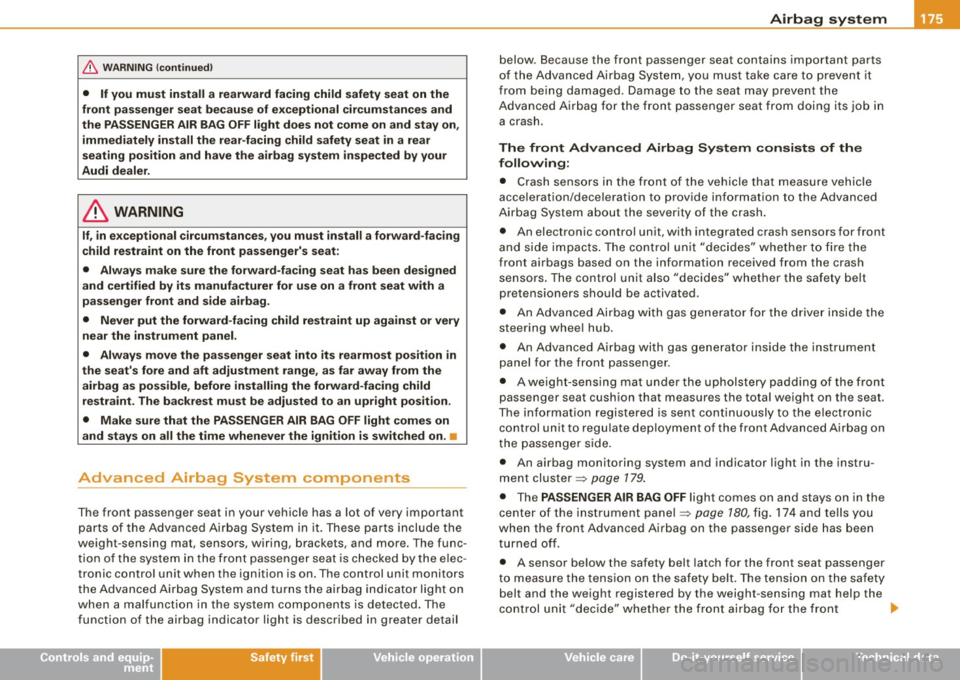
Airbag system -----------------=~-
& WARNING (continued)
• If you must install a rearward facing child safety seat on the
front passenger seat because of exceptional circumstances and
the PASSENGER AIR BAG OFF light does not come on and stay on,
immediately install the rear -facing child safety seat in a rear
seating position and have the airbag system inspected by your
Audi dealer.
_& WARNING
If, in exceptional circumstances, you must install a forward-facing
child restraint on the front passenger's seat:
• Always make sure the forward-facing seat has been designed
and certified by its manufacturer for use on a front seat with a
passenger front and side airbag .
• Never put the forward-facing child restraint up against or very
near the instrument panel.
• Always move the passenger seat into its rearmost position in
the seat's fore and aft adjustment range, as far away from the
airbag as possible, before installing the forward-facing child
restraint. The backrest must be adjusted to an upright position.
• Make sure that the PASSENGER AIR BAG OFF light comes on
and stays on all the time whenever the ignition is switched on. •
Advanced Airbag System components
The front passenger seat in your vehicle has a lot of very important
parts of the Advanced Airbag System in it. These parts include the
weight-sensing mat, sensors, wiring, brackets, and more. The func
tion of the system in the front passenger seat is checked by the elec
tronic control unit when the ignition is on. The control unit monitors
the Advanced Airbag System and turns the airbag indicator light on
when a malfunction in the system components is detected. The
function of the airbag indicator light is described in greater detail
Controls and equip ment Safety first Vehicle operation
below.
Because the front passenger seat contains important parts
of the Advanced Airbag System, you must take care to prevent it
from being damaged. Damage to the seat may prevent the
Advanced Airbag for the front passenger seat from doing its job in
a crash.
The front Advanced Airbag System consists of the
following:
• Crash sensors in the front of the vehicle that measure vehicle
acceleration/deceleration to provide information to the Advanced
Airbag System about the severity of the crash.
• An electronic control unit, with integrated crash sensors for front
and side impacts. The control unit "decides" whether to fire the
front airbags based on the information received from the crash sensors. The control unit also "decides" whether the safety belt
pretensioners should be activated.
• An Advanced Airbag with gas generator for the driver inside the
steering wheel hub.
• An Advanced Airbag with gas generator inside the instrument
panel for the front passenger .
• A weight-sensing mat under the upholstery padding of the front
passenger seat cushion that measures the total weight on the seat.
The information registered is sent continuously to the electronic
control unit to regulate deployment of the front Advanced Airbag on
the passenger side.
• An airbag monitoring system and indicator light in the instru
ment cluster ~
page 179.
• The PASSENGER AIR BAG OFF light comes on and stays on in the
center of the instrument panel~
page 180, fig. 174 and tells you
when the front Advanced Airbag on the passenger side has been
turned off .
• A sensor below the safety belt latch for the front seat passenger
to measure the tension on the safety belt. The tension on the safety
belt and the weight registered by the weight -sensing mat help the
control unit "decide" whether the front airbag for the front _,.
Vehicle care Do-it-yourself service Technical data
Page 178 of 340

___ A_ ir_ b_ a~g _ s_ y_ s_ t _e_ m ___________________________________________________ _
passenger seat shou ld be turned off o r not=> page 1 70, "C hild
r es train ts on the fron t sea t - som e impo rtant thin gs to kno w".
• A sensor in the safety belt latch for the driver and fo r the front
s e at pass enger that s enses w hether tha t sa fety b elt is la tc he d o r no t
and transmits this information to the el ectronic control unit.
& WARNING
Damage to the front passenger seat can prevent the front airbag
from working properly .
• Improper repair or disassembly of the front passenger and
driver seat will prevent the Advanced Airbag System from func
tioning properly.
• Repairs to the front passenger seat must be performed by qual
ified and properly trained workshop personnel.
• Never remove the front passenger or driver seat from the
vehicle.
• Never remove the upholstery from the front passenger seat .
• Never disassemble or remove parts from the seat or disconnect
wires from it .
• Never carry sharp object s in your pockets or place them on the
seat . If the weight-sensing mat in the passenger seat is punctured
it cannot work properly.
• Never carry things on your lap or carry objects on the
passenger seat. Such items can increase the weight registered by
the weight-sens ing mat and send the wrong information to the
airbag control unit .
• Never store items under the front passenger seat. Parts of the
Advanced Airbag System under the passenger seat could be damaged , preventing them and the airbag system from working
properly.
• Never place seat covers or replacement upholstery that have
not been specifically approved by Audi on the front seats.
& WARNING (continued )
• Seat covers can prevent the Advanced Airbag System from
recognizing child restraints or occupants on the front passenger
seat and prevent the side airbag in the seat backrest from
deploying properly .
• Never use cushions, pillows, blankets or similar items on the
front passenger seat . The additional padding will prevent the
weight-sensing mat in the seat from accurately registering the
child restraint or person on the seat and prevent the Advanced
Airbag System from functioning properly.
• If you must use a child restraint on the front passenger seat
and the child restraint manufacturer's instructions require the use
of a towel , foam cushion or something else to properly position
the child restraint , make certain that the PASSENGER AIR BAG OFF
light comes on and stays on whenever the child restraint is
i nstalled on the front passenger seat .
• If the PASSENGER AIR BAG OFF light does not come on and stay
on , immediately install child restraint in a rear seating position
and have the airbag system inspected by your Audi dealer. •
How the Advanced Airbag System
components work together
The front Advanced Airbag System and the si de airba gs supp lement
t h e protection offe red by the front three -point safety be lt s with
pretensioners and load limiters and the adjustab le head restraints
to help reduce the risk of in jury in a wide range of accident and
cras h situati ons . Be sure to read the im por tant in fo rmati on a bout
safety and heed the WARN INGS in this chapter.
De ploy men t of the Advanc ed A ir b ag Syst em and the activa tion of
th e safety belt pretens ioner d epends on the dece leration measured
b y the c ra sh se nsors and reg istered by the elec tronic co ntrol un it .
C rash severity depends on speed and dece leration as well as the
mass an d stiff ness of the vehicle o r obj ect invo lved in the c ra sh.
~
Page 179 of 340
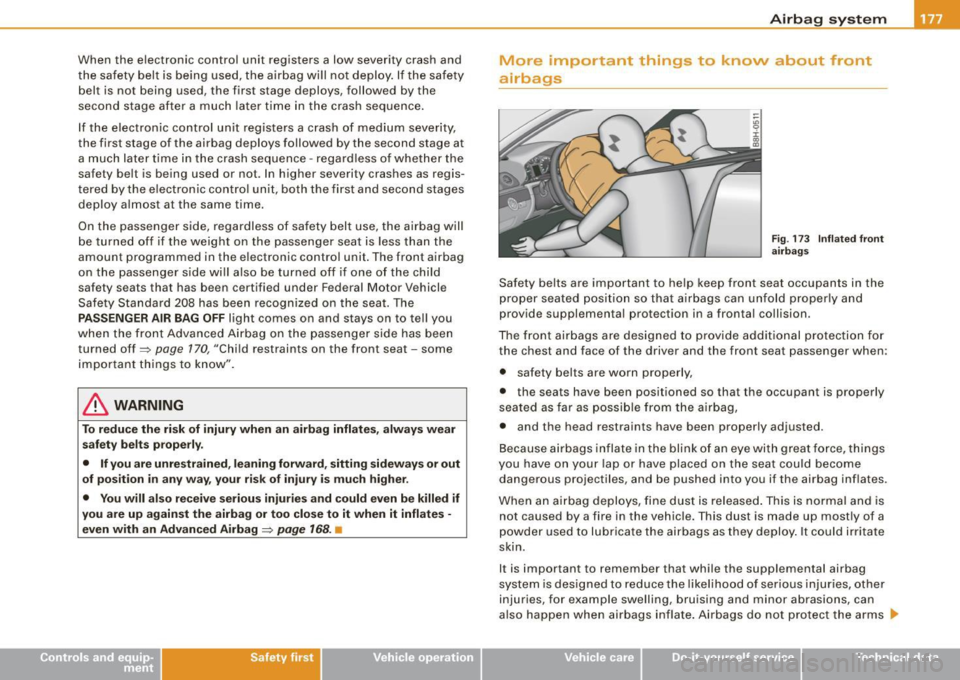
When the electronic control unit registers a low severity crash and
the safety belt is being used, the airbag will not deploy . If the safety
belt is not being used, the first stage deploys, followed by the
second stage afte r a much later time in the crash sequence.
If the electronic control unit registers a crash of medium severity,
the first stage of the airbag deploys followed by the second stage at
a much later t ime in the crash sequence -regardless o f whether the
safety belt is being used or not. In higher severity crashes as regis
tered by the e lectronic contro l unit, both the first and second stages
deploy almost at the same time.
On the passenger side, regardless of safety belt use, the airbag will
be turned off if the weight on the passenger seat is less than the
amount programmed in the e lectronic control unit . The front airbag
on the passenger s ide will a lso be turned off if one of the child
safety seats that has been certified under Federal Motor Vehicle
Safety Standard 208 has been recognized on the seat. The
PASSENGER AIR BAG OFF light comes on and stays on to tell you
whe n the front Advanced Airbag on the passenger side has been
turned off=>
page 170, "Child restraints on the front seat -some
impor tan t things to know".
& WARNING
To reduce the risk of injury when an a irbag infl ates , always wear
s afet y belts properly .
• If you are unre stra ined , leaning forward , sitting sideway s or out
of position in any w ay, your risk of in jur y i s mu ch hi gher.
• You will als o recei ve se riou s injurie s and could e ven b e killed if
you are up again st the airbag or too clo se to it when it inflate s -
even with an Advanced Airbag =>
page 168 . •
Safety first
Airb ag syst em
More important things to know about front
airbags
F ig . 173 Inflated front
airba gs
Safety belts are important to he lp keep front seat occupants in the
proper seated position so tha t airbags can unfold properly and
provide supplementa l protection in a fronta l collision.
The front airbags are designed to provide additional protection for
the chest and face of the driver and the front seat passenger when: • safety belts are worn properly,
• the seats have been positioned so that the occupant is properly
seated as far as possib le from the a irbag,
• and the head restraints have been properly adjusted.
Because a irbags inflate in the blink of an eye with great force, thi ngs
you have on your lap or have placed on the seat could become
dangerous projectiles, and be pushed into you if the airbag inflates.
When a n airbag deploy s, fine dust is released . This is normal and is
not caused by a fire in the vehicle. This dust is made up mostly of a
powder used to lubrica te the airbags as they deploy . It could irri tate
skin.
It is important to remember that while the supplemental airbag
system is designed to reduce the likelihood of serious injuries, other
injuries, for example swelling, bruising and minor abrasions, can
a lso happen when airbags infla te . Airbags do no t pro tect the arms ...
~ehicle care irechnical data
Page 180 of 340
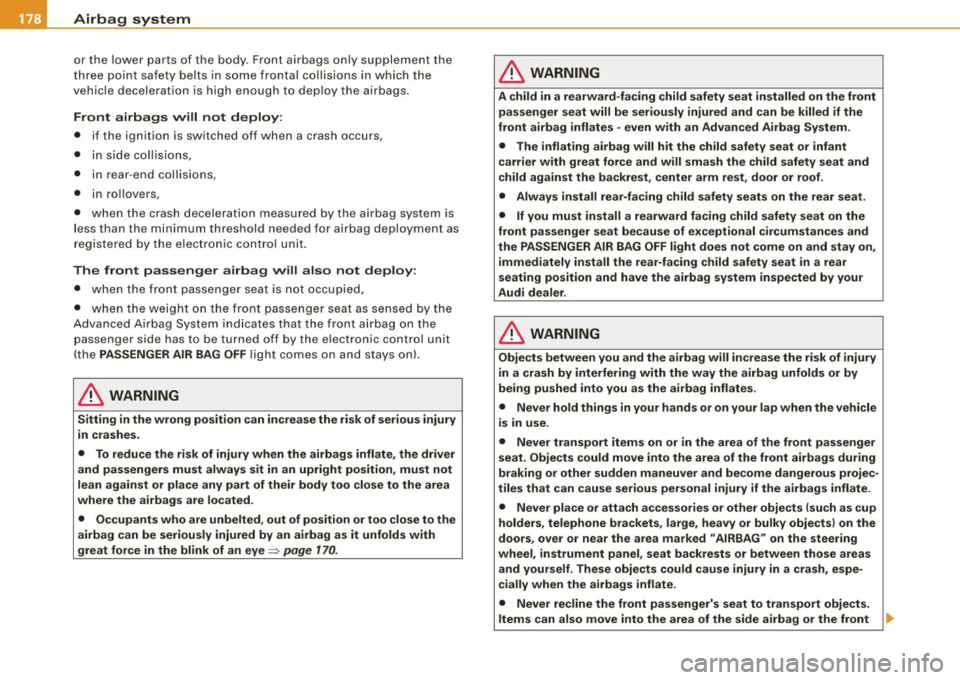
__ __::_A:::..:..:. ir..::b ~ a::. g::!...: s:::L y..::s :.::t :.::e :.:.m.:..:.... ________________________________________________ _
or the lower parts of t he body. Front airbags on ly supp lement the
th ree p oint safe ty belts in s ome front al c olli sio ns in which the
vehic le dece leration is high enou gh to deploy th e airbags .
Front airbags will not deploy:
• if the ignition is switched off when a crash occ urs,
• i n sid e coll is ions ,
• i n rea r- e nd collisi ons ,
• in rollovers,
• when th e c ras h de cele rat io n measu red by th e airba g sys tem is
l ess than the minimum threshold needed for a irbag deplo yment as
r egi stere d by t he ele ctr onic con trol unit.
The front passenger airbag will also not deploy :
• whe n t he fr ont pass enge r sea t is not occup ied,
• when the weight on the front passenger seat as sensed by the
A dvanced A ir b ag Sys te m in d ica tes th at the fr ont airba g on the
p assenge r side has to be t urned off b y the e lectronic cont rol unit
(t he
PASSENGER AIR BAG OFF ligh t com es o n an d stays o nl.
& WARNING
Sitting in the wrong posit ion can increase the risk of serious injury
in crashes .
• To reduce the risk of injury when the airbags inflate , the driver
and passengers must always sit in an upright position , must not
lean against or place any part of the ir body too close to the area
where the airbags are located.
• Occupants who are unbelted , out of posit ion or too close to the
airbag can be seriously injured by an airbag as it unfolds with
great force in the blink of an eye:::::,
page 170 .
& WARNING
A child in a rearward-facing child safety seat installed on the front
passenger seat will be seriously injured and can be killed if the
front airbag inflates - even with an Advanced Airbag System .
• The inflating airbag will hit the child safety seat or infant
carrier with great force and will smash the child safety seat and
child against the backrest , center arm rest , door or roof.
• Always install rear-facing child safety seats on the rear se at.
• If you must install a rearward facing child safety seat on the
front passenger seat because of exceptional circumstances and
the PASSENGER AIR BAG OFF light does not come on and stay on, i mmediately install the rear-facing child safety seat in a rear
seating position and have the airbag system inspected by your
Audi dealer .
& WARNING
Objects between you and the airbag will increase the risk of injury
in a crash by interfering with the way the airbag unfolds or by
being pushed into you as the airbag inflates .
• Never hold things in your hands or on your lap when the vehicle
is in use.
• Never transport items on or in the area of the front passenger
seat. Objects could move into the area of the front airbags during
braking or other sudden maneuver and become dangerous projec
tiles that can cause serious personal injury if the airbags inflate .
• Never place or attach accessories or other objects (such as cup
holders , telephone brackets , large, heavy or bulky obje cts) on the
doors , over or near the area marked "AIRBAG" on the steering
wheel, instrument panel , seat backrests or between those areas
and yourself . These objects could cause injury in a crash, espe
cially when the airbags inflate .
• Never recline the front passenger's seat to transport objects .
Items can also move into the area of the side airbag or the front ..,